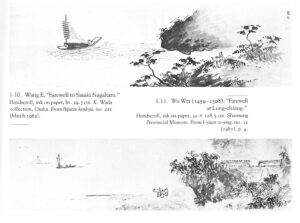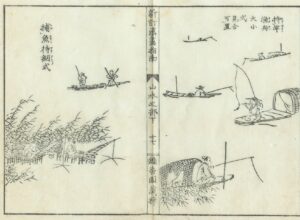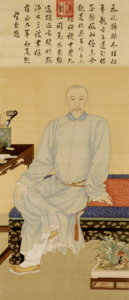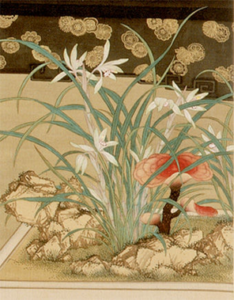We talked about James Cahill’s. The Painter’s Practice: How Artists Lived and Worked in Traditional China. . New York: Columbia University Press, 1994 in class recently. You might be under the impression that Chinese artists (calligraphers, painters) lived only for Art and Truth, and disdained the material world. There was indeed a cult of the amateur artist that you can read about in the works of, well, James Cahill. He also wrote this book. Here is a quote from a friend on Zheng Min 鄭旼
The master immerses himself in old books, not caring whether it is cold or hot, living tranquilly, uttering few words, magnanimous in disposition, his mind fixed on distant goals [that is, unconcerned with day-to-day affairs]. All difficult questions in the classics and histories he can resolve. He is an accomplished seal carver, using the pre-Ch’in and Han [scripts] as models. His painting style is lofty and antique, completely following the ch’i-yin sheng-tung (“engendering movement through spirit consonance”) mode of expression. Accordingly, he can rival the Yuan masters. In the most refined of his works, whether feelings of sadness and melancholy or complaint and anger, if these were not aroused by his great talents then they must come from his own experience. Cahill Painter’s Practice p.g 4
A true artist. Here is one of his works
This is from an album of scenes of Huangshan He did two of these, one for a friend, and one for a friend of a friend. As he wrote in the inscription “In the future, after all his children get married, if Chuzhen ever travels there, I hope he will take this album with him to check against the actual sites. I will then become his tour guide.” This may make it sound like a gift of friendship, for a friend he has never met. As his diary shows, however, he sold art for money.
[1672] tenth month, fifth day: I did three fan paintings for Fu-wen.
Seventeenth day: cloudy. Yen-ch’ing and K’uan-chung “moistened my brush” [gave me money for painting] and I added bamboo and rock for them [to some previously done painting?]
Eleventh month, eighth day: I went into town and wrote a fan for Yen-ch’ing. . . Keng-yu summoned me, and I added to [retouched?] a painting by T’ang Yin for him …
(1673] sixth month, third day … Mu-ch’ien ordered a painting for Hsu Erh-ming, and I used the money for food.
(1674] second month, sixth day: cloudy. After supper I visited Tzu-yen, and entrusted him with three paintings to sell for me.
Sixth month, sixth day: I visited Hsiueh-hai, where the owner of the I-kuan [an inn ?] … Summoned me to do a painting for him.
(1676] first month, sixth day: rainy. Ssu-jo visited me to order a painting, bringing payment [lit. “moisture,” as above .]
Ninth month, eighteenth day: for my “elder brother“ Yin-nan I did a painting on satin. Also did five fans for . . . [names].
Twelfth month , fourth day: This line [of poetry] came to me: “To get through the year, I need the money from selling paintings.”
Twenty-ninth day. Snow has been falling for the whole month. Fortunately, I have managed to get through my New Year’s obligations with the small income from my paintings. I sit recalling that there are a great many really poor people now, and wish that I had a spacious, myriad-roomed house [to entertain them in]-an empty thought.
I am pretty sure that for enough cash Zheng Min would be your actual tour guide.
The book explains the business of art, but also less blatantly financial ways that art changed hands as gifts and favors. A talented painter who wants to keep eating needs to be able to both crank out the work and understand the social symbolism that his customers want to buy. A fine job for a failed scholar. These were the people who could crank out quick “parting paintings” for themselves or others. The perfect gift.
If you are not sure how to do one, well there are painting manuals for that. From a Japanese edition of Mustard Seed Garden
Of course the truly great artist could do amazing work while cranking things out on a deadline with a lot of patron meddling and pandering to the market. At a higher level you could get more bespoke work. Cahill talks about the symbolism of of a gift of a painting of plum blossoms, but I talked about orchids instead.
The orchid can grow in the wild, and so it is a good symbol of the under-appreciated scholar.
If an orchid grows in the deep forest, with no one present, is it not still fragrant? A gentleman cultivates the way and establishes his virtue and does not let his integrity whither although hard-pressed by poverty
且芝蘭生於深林,不以無人而不芳,君子修道立德,不為窮困而敗節
from 孔子家語
Put an orchid in a pot and it is a symbol of the wild and free scholar who happens to have a job. This is probably how they are used in this portrait of Yinli, Prince Guo
As a Manchu prince, Yinli was not starving the forest,but he did like posing as a scholar. The inscription on the painting is a poem written by the prince:
Humbled that through my kinship to the throne,
I was allotted a scepter in the prime of life,
I shall hold fast to the Way of antiquity,
And hope to preserve it without transgression.
Availing himself of this fine white silk,
That my figure may be transmitted on it,
The painter was indeed a marvelous hand,
Who erred in neither ugliness or beauty,
What is stored within is displayed without,
He has captured here my character as well.
Refraining from any wanton extravagance,
I shall follow in the footsteps of the former sages,
And by the bright window, at my clean desk,
Thrice replace the worn-out bindings on my books.
(Translation by Stephen D. Allee)
Money may or may not have changed hands here. but the artist is clearly helping both the subject and himself function as an “entrepreneur of the self” (Cahill pg. 144) The artist is selling a sample of his skill and culture and the buyer is buying it.1 This is not the same as loading your calligraphy on a donkey and taking it to town and selling it to whoever and using the money for wine, but it is on the same continuum.
Posted so I can teach this point again someday. And now so can you.
This is not that different from Western art. Rembrandt is the comparison of the “entrepreneur of the self” Cahill uses here ↩




